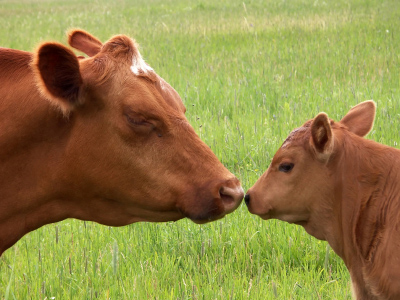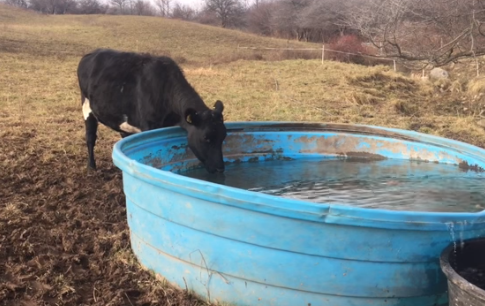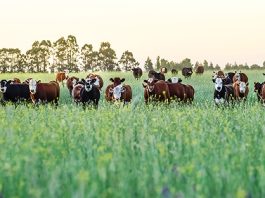Editors Note: This is Part 4 in Darrell’s series on understanding our animals so that we can do the best job of managing our pastures. Here are links to Part 1, Part 2 and Part 3.
Here’s where we left off last time: Animals follow the “Law of Least Effort” when it comes to finding food. They won’t hang out for long where there is little or no food, where the foods found in a location do not meet their particular nutritional requirements, or the foods are too difficult to handle. Thus, the food an herbivore selects is determined not only by the nutrient content of the food, but also the costs involved in handling and processing the food, and by the food’s abundance.
However, the foraging behavior of pasture predators such as “Happy” the horse, “Lily” the lamb and “Harriet” the holstein is a complex and dynamic process, and while no predator, in the long term, can disregard the “Law of Least Effort,” there are some short term exceptions. Let’s take a look.
Animals Have to Learn What to Eat
 Foraging behavior and diet selection are primarily learned behaviors. Thus, young animals have to learn what to eat, when, and where. Animals that are moved into or in some other way find themselves in unfamiliar locations must also learn the lay of the land as well as evaluate the foods that are available. And sometimes animals become ill and can be found to eat plants that are not overly nutritious or abundant, but have medicinal value.
Foraging behavior and diet selection are primarily learned behaviors. Thus, young animals have to learn what to eat, when, and where. Animals that are moved into or in some other way find themselves in unfamiliar locations must also learn the lay of the land as well as evaluate the foods that are available. And sometimes animals become ill and can be found to eat plants that are not overly nutritious or abundant, but have medicinal value.
Pasture predators such as “Happy” the horse, “Lily” the lamb, “Harriet” the holstein and all of their herbivorous cousins—both wild and domestic– have foraged lips to leaves for millions of years. And they are really good at it. However, selecting what to eat can be dangerous. Consuming the wrong plant at the wrong time or eating too much of one plant and not enough of another can cause sickness, malnutrition and even death. Moreover, foraging in locations where the foods are not nutritionally adequate, sufficiently abundant, or are too tall or too short for attaining high rates of intake, simply increases the time they spend looking for food, which decreases the foraging efficiency of the animal, reduces their intake, and lowers performance.
Fortunately, animals are well-equipped to learn, and start by learning from mother and herd mates, and then from their own experience. As I mentioned in a previous article in On Pasture, “Herbivores have been selecting and securing their own food for millions of years. They use their eyes to locate general foraging locations and sometimes even individual plants or parts of plants (not to mention keeping an eye out for things that would like to make a meal of them), their sense of smell to evaluate the hundreds of volatile gases that are given off by plants as well as the environment around the plants, their sense of touch to evaluate texture and fiber value, and their sense of taste to differentiate among flavors (sweet, salty, sour, bitter, and perhaps umami, pungent, and metallic.) And once the forage has been eaten, it is further evaluated postingestively by osmotic, mechanical, and chemical receptors residing within the animal’s gut.”
 New Things Can Be Scary
New Things Can Be Scary
Most creatures are neophobic when it comes to food. This means they are reluctant to eat novel foods, or foods they have not experienced before, even if they are nutritionally adequate. For an herbivore to readily consume a particular plant; the plant must be recognized as familiar by the animal and contain some desirable attribute. Familiar foods are viewed as safe, while unfamiliar foods are viewed as potentially dangerous. Keep in mind; it is not in the best interest of the individual to eat the most toxic plant in a pasture
Variety Keeps Creatures Healthy

Nor is it in the best interest of an individual to keep eating the same food hour after hour, day after day, and week after week. While familiarity with a food item that meets a particular nutritional requirement is a precursor to high initial intake, animals, over time, can develop what are known as “conditioned taste aversions.” Conditioned taste aversions are believed to have evolved as a survival mechanism that inhibits animals from over-ingesting foods that may be nutritionally adequate but contain toxins, or foods that are inadequate (excessive or inadequate) in nutrients that, perhaps, taste good. Taste aversions can result in an animal foraging less than optimally for short periods of time.
Management Implications
Grazing animals have a long history of effectively sorting out what is good to eat from the stuff that is not so good. Time and time again, studies have shown they routinely select diets that are higher in nutrients and lower in toxins than the average of that which can be found in their grazing environments. This is more than just the ‘luck of the bite”, this is an expressed behavior. Hence, to ensure that your animals are getting every opportunity to select the plants and parts of plants that best meet their nutritional requirements, it is highly recommended that your pastures consist of diverse mixtures of species. No matter how good the claim for any single species, no single species can provide the diversity of nutrients over the long term as a mix of plant species can.

Never surprise your animals with a brand new food. Grazing animals are creatures of habit and they like what they are familiar with and have a distrust of new or novel foods. Familiar foods are viewed as “safe” while new or unknown foods are viewed as potentially “dangerous”. If mom didn’t show it to them and they have not had a chance to evaluate it through postingestive effects, chances are intake will, at least in the short term, be relatively light. When animals are placed in pastures with unfamiliar species, the time spent foraging generally increases but intake generally decreases. However, if the new food seems to meet a nutritional requirement and causes no discomfort or illness, it could, given enough time and testing, become a preferred food.
Never over-work your animals by expecting them to forage in places they are not adapted to or in pastures consisting of forages that are not suitable in quality or quantity. The “Law of Least Effort” imposes serious consequences for those violating its tenets.
As livestock owners and managers, it is vitally important to recognize that animals are fundamentally different than machines. While machines do not care what a forage feels like, taste likes or smells like, grazing animals do. And when animals express their concerns, it is usually in terms of a decrease in performance. The more we can accommodate, rather than dictate, their needs the more contented and productive they will be.




